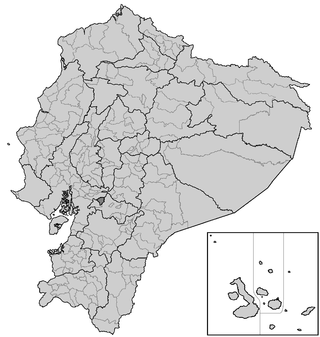Top Qs
Timeline
Chat
Perspective
Cantons of Ecuador
Second-level administrative divisions of Ecuador From Wikipedia, the free encyclopedia
Remove ads
The cantons of Ecuador are the second-level subdivisions of Ecuador, below the provinces. The cantons are further subdivided into parishes, which are classified as either urban or rural.

As of 2025, there are 222 cantons in the country. The most recently created cantons are Sevilla Don Bosco in Morona Santiago Province in 2024;[1][2] and La Concordia in Esmeraldas Province in 2007, although in 2013 La Concordia was transferred to Santo Domingo de los Tsáchilas Province.[3][4]
Below is a list of cantons by province.
Remove ads
Azuay Province (15 cantons)
Remove ads
Bolívar Province (7 cantons)
Cañar Province (7 cantons)
Carchi Province (6 cantons)
Chimborazo Province (10 cantons)
Cotopaxi Province (7 cantons)
El Oro Province (14 cantons)
Remove ads
Esmeraldas Province (7 cantons)
Galápagos Province (3 cantons)
Guayas Province (25 cantons)
Remove ads
Imbabura Province (6 cantons)
Loja Province (16 cantons)
Los Ríos Province (13 cantons)
Manabí Province (22 cantons)
Morona-Santiago Province (13 cantons)
Napo Province (5 cantons)
Orellana Province (4 cantons)
Pastaza Province (4 cantons)
Pichincha Province (8 cantons)
Santa Elena Province (3 cantons)
Santo Domingo de los Tsáchilas Province (2 cantons)
Sucumbíos Province (7 cantons)
Tungurahua Province (9 cantons)
Zamora-Chinchipe Province (9 cantons)
Non-delimited areas
Four areas in Ecuador previously did not belong to any province. These were:
- Las Golondrinas: In a referendum held on April 3, 2016, 56.9% of voters voted in favor of Las Golondrinas being incorporated into the Imbabura Province.[5]
- La Manga del Cura: In a referendum held on September 27, 2015, 64.2% of the voters voted in favor of La Manga del Cura being incorporated into the Manabí Province.[6]
- El Piedrero and Matilde Esther: incorporated into Guayas Province by presidential decree in 2017.[7]
Authorities
In each canton there is a jefe político, chosen by, and representing the interests of, the president. There is also a mayor (alcalde) and a municipal council (concejo municipal), chosen by popular vote.
See also
References
Wikiwand - on
Seamless Wikipedia browsing. On steroids.
Remove ads
